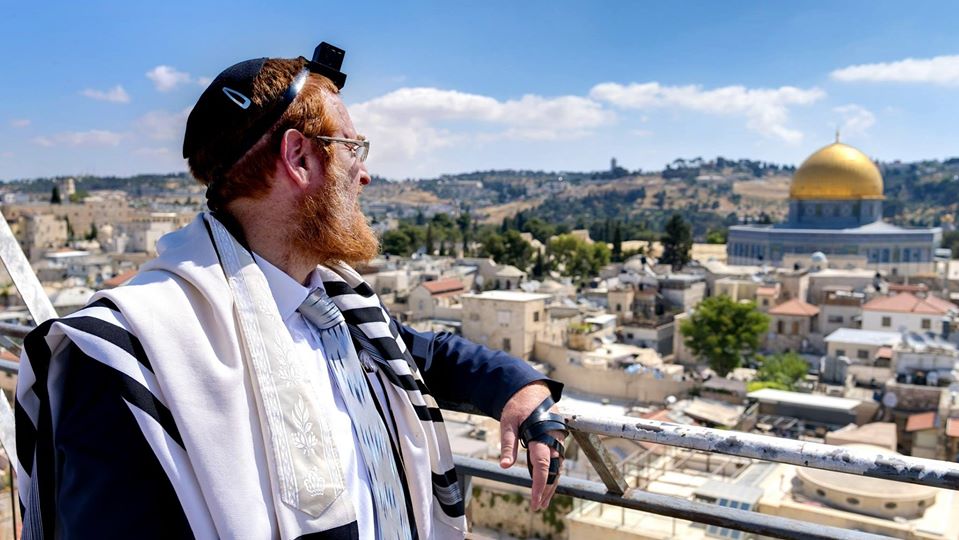The “public interest” denies Jews the right to pray at their ancient and holiest site.
By Jerold S. Auerbach, JNS.org
Several decades ago, during a visit to the Old City of Jerusalem, I was chatting with Mahmoud, my favorite antiquities dealer who had become a treasured friend and teacher. With business slow that morning, he invited me to join him for a tour of the Temple Mount.
After circling the Dome of the Rock, he took me to the vast empty cavern below. There was nothing but a dirt floor and scattered rocks of various sizes. I had hoped that I might find something that I could add to my antiquities collection, but I had to settle for a small stone.
Increasingly fascinated with ancient Jewish history in Jerusalem, I learned that King Solomon had built the First Temple on this site nearly 3,000 years ago. Destroyed by Babylonians in 586 BCE, Jews returned from exile to build their Second Temple here. It, too, was destroyed by the Romans in 70 C.E. Six centuries later, Muslims built the Dome of the Rock, their sacred site ever since.
The location surely was not random. Permitted to visit but prohibited from praying there, Jews embraced the Western Wall of the Temple Mount as their revered holy remnant.
Deprived by Muslims of access to the Old City after Israel’s War of Independence in 1948, it took nearly two decades before its victory in the Six-Day War transformed Jerusalem. On the second day, after Israeli soldiers captured the Old City, Col. Mordechai Gur excitedly announced: “The Temple Mount is in our hands.”
Israeli Defense Minister Moshe Dayan declared: “Here stood our Temple during ancient time, and it would be inconceivable for Jews not to be able freely to visit this holy place now that Jerusalem is under our rule.”
But fearful of a holy war with Muslims, Dayan soon reneged. After meeting with Muslim authorities he agreed that Jews would be permitted to visit the Temple Mount but were prohibited from vocal prayer at the site of their ancient Temples. Israeli police permitted silent prayer, without tallit or tefillin.
Rabbi Aryeh Lippo was recently removed from the Mount for 15 days for praying there—silently—during his Yom Kippur visit. He cited the Holy Places Law, protecting them from desecration while prohibiting “anything likely to violate the freedom of access of the members of the different religions to the places sacred to them.” This law, Rabbi Lippo noted, applies to Jews “and the most sacred place for the people of Israel [is] on the Temple Mount.”
Rabbi Lippo’s appeal of the police prohibition of Jewish prayer was upheld by a Magistrates Court Judge, which recognized that his daily arrival at the Temple Mount “indicates that this is a matter of principle and substance for him.” She noted that he “stood in a corner with a friend or two, there was no crowd around him, his prayer was quiet, whispered.” Her ruling was sharply challenged by both Muslims and Israelis.
Predictably the Waqf, the Islamic religious trust that manages the Temple Mount, called it a “flagrant violation” of Muslim sanctity. Israeli Security Minister Omer Barlev announced that the ruling would be appealed because “a change in the status quo will endanger the public peace and could cause a flare-up.” Claiming that Israel “advocates freedom of worship and prayer for all,” he nonetheless asserted that “the prayer of Jews … will take place next to the Western Wall” not above it.
Israel’s Supreme Court waffled. In an earlier ruling this year, it asserted that “every Jew has the right to pray on the Temple Mount, as part of the freedom of religion and expression.” But “these rights are not absolute and can be limited to take into account the public interest.”
Evidently, the “public interest” denies Jews the right to pray at their ancient and holiest site. So the Temple Mount will remain the “Mosque Mount,” ironically with the Jewish state as its protector.
To assure perpetual Muslim control, 9,000 tons of dirt beneath the Temple Mount was ordered removed by Muslim authorities and dumped in the nearby Kidron Valley. A new mosque was built below the mount, obliterating any possibility that Jews might claim the site as theirs.
Ingeniously, a Temple Mount sifting project was formed, attracting volunteers to search the dirt for remnants of Jewish history. Thousands of ancient Jewish artifacts have been discovered, including weights, coins, seals, arrowheads and a pot shard etched with a menorah.
Rabbi Lippo chose the appropriate Jewish site for his prayers. How shameful that Israeli officials would punish him for his religious devotion to Jewish history.
Jerold S. Auerbach is the author of “Hebron Jews: Memory and Conflict in the Land of Israel” and “Print to Fit: The New York Times, Zionism and Israel 1896-2016,” which was recently selected for Mosaic by Ruth Wisse and Martin Kramer as a “Best Book” for 2019.


